How quickly the narrative can change around football. Just 48 hours ago, the perceived chatter surrounding Manchester United was that they were in trouble as their new coach, Eric ten Hag, was off to a difficult start.
This was, of course, on the back of defeats in the opening two matches of the 2022/23 Premier League season against Brighton and Brentford. The issue though wasn’t purely with the defeats but with the nature of the performance, as United were comfortably outclassed in both matches. With that storyline permeating every aspect of the football club the last thing that many wanted, supporters especially, was a visit from fierce rivals Liverpool on Monday night.
The reality was though that this was a Liverpool side who had also started their season slowly with draws away to Fulham and at home to Crystal Palace. Their performances were largely forgotten about as United sat at the bottom of the Premier League table.
In the end, this match has firmly switched the prevailing narrative around the Premier League as Man United ran out 2-1 winners on the back of some brave and decisive coaching decisions from Ten Hag.
In this tactical analysis we will break down the key tactical factors around this match.
Team news
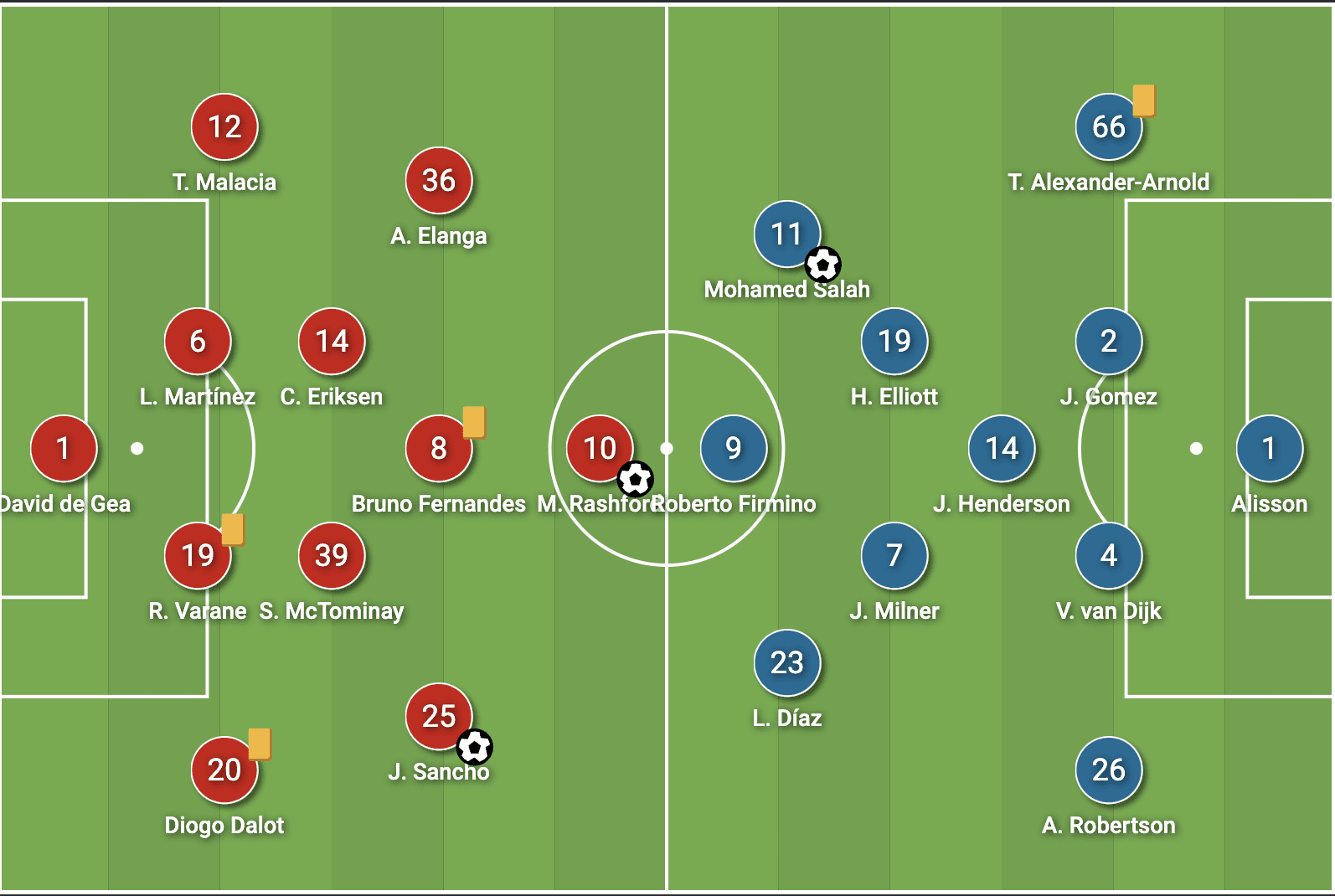
The headline-grabbing team news came from the home side with club captain Harry Maguire and talismanic forward Cristiano Ronaldo both dropped to the bench. We saw Raphael Varane brought into the defensive unit to partner Lisandro Martinez while Marcus Rashford shifted from the left side of the attack to play in a more central role with Anthony Elanga coming in on the left wing.
Straight away these changes appeared to give United a sense of poise but also a really dynamic attacking threat with Rashford, Elanga and Jadon Sancho all having the capacity to make aggressive runs behind the opposition defensive line.
Liverpool recalled their Brazilian international forward Roberto Firmino to replace the suspended Darwin Nunez as Joe Gomez came back into the defensive line to replace Nat Williams. It was in the midfield, however, that Liverpool looked light with Fabinho not fit enough to start Jordan Henderson had to drop in as the ‘6’ with James Milner and Harvey Elliot as the ‘8’s. As the game went on, however, the lack of Henderson as that right-sided ‘8’ would prove costly for Liverpool.
United press from the off
When the German coach Ralf Rangnick came in to replace Ole Gunnar Solskjaer as United coach mid-way through the 2021/22 season he did so with an understanding that he would look to implement a counter-pressing style of play within the squad. United were expected to play in a style similar to Liverpool with aggression off the ball to prevent the opposition from playing out comfortably and designed to allow them to regain possession as close to the opposition goal as possible. As the season unfolded, however, Rangnick dropped his plan to press and United began to look passive and ineffective against the ball. The prevailing thought at the time was that the German coach had assessed the squad at his disposal and realised that they were ill-suited to a constant pressing game.
This match was the first time that we have seen this much aggression and dynamism against the ball from Ten Hag’s United. The cynical among us might glance towards the United bench where Cristiano Ronaldo sat and watched his team harry and harrass the Liverpool build-up and wonder if the Portuguese striker, who is still a very effective and clinical goalscorer, is perhaps not as well suited to this style of play as the likes of Marcus Rashford or Anthony Martial.
The same can be said of Harry Maguire, whose lack of positional sense and anticipation can sometimes see him struggle to defend effectively in space against the opposition transition. With the introduction of Varane alongside Martinez in the centre of the United defence, the home side looked far more solid.
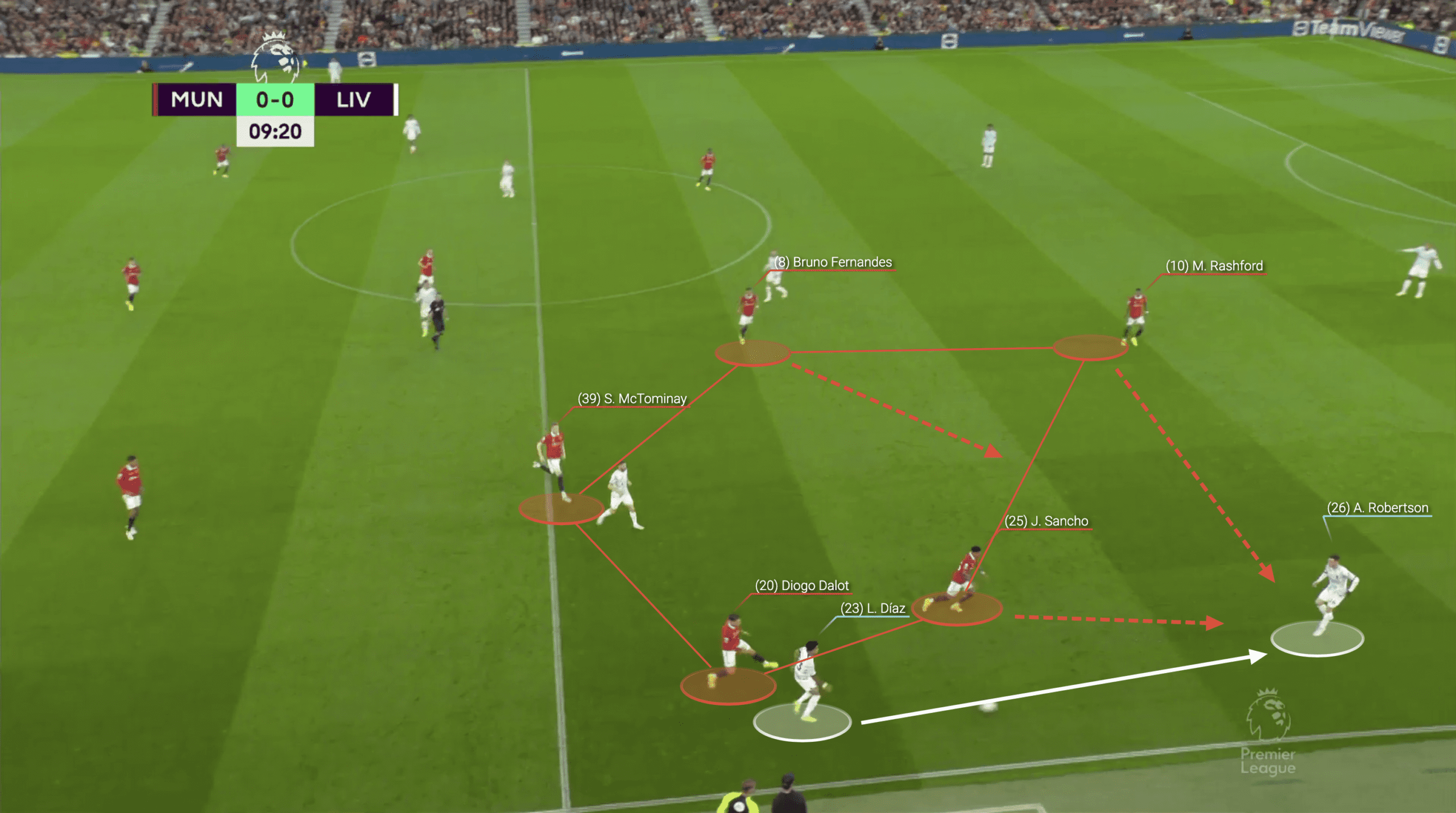
Throughout the game United were aggressive in jumping on any mistake that Liverpool made in possession as they pressed aggressively and jumped as a team on certain pressing triggers. With the lack of Fabinho and Thiago in the Liverpool midfield, there was a lack of a real ball progressor in the central areas for Liverpool and as such, they tried to build their attacks down the outside.
Ten Hag had his fullbacks engage aggressively when the Liverpool wingers received with their back to goal as he looked to force them to pass back to the fullback. This was a clear pressing trigger throughout the match as United would then swarm forward aggressively to try to force a mistake or a turnover in possession. We see an example of this here as Andy Robertson had initially looked to play a pass down the line to Luis Diaz. The Colombian forward, however, could not get turned because the United right-back, Diogo Dalot, was pressing aggressively at his back. The only pass on then was to bounce the ball back to Robertson. As soon as this pass was made we saw Sancho, Rashford and Fernandes move across to squeeze the left-back.
A mistake was then made when Robertson tried to force the ball out of pressure.
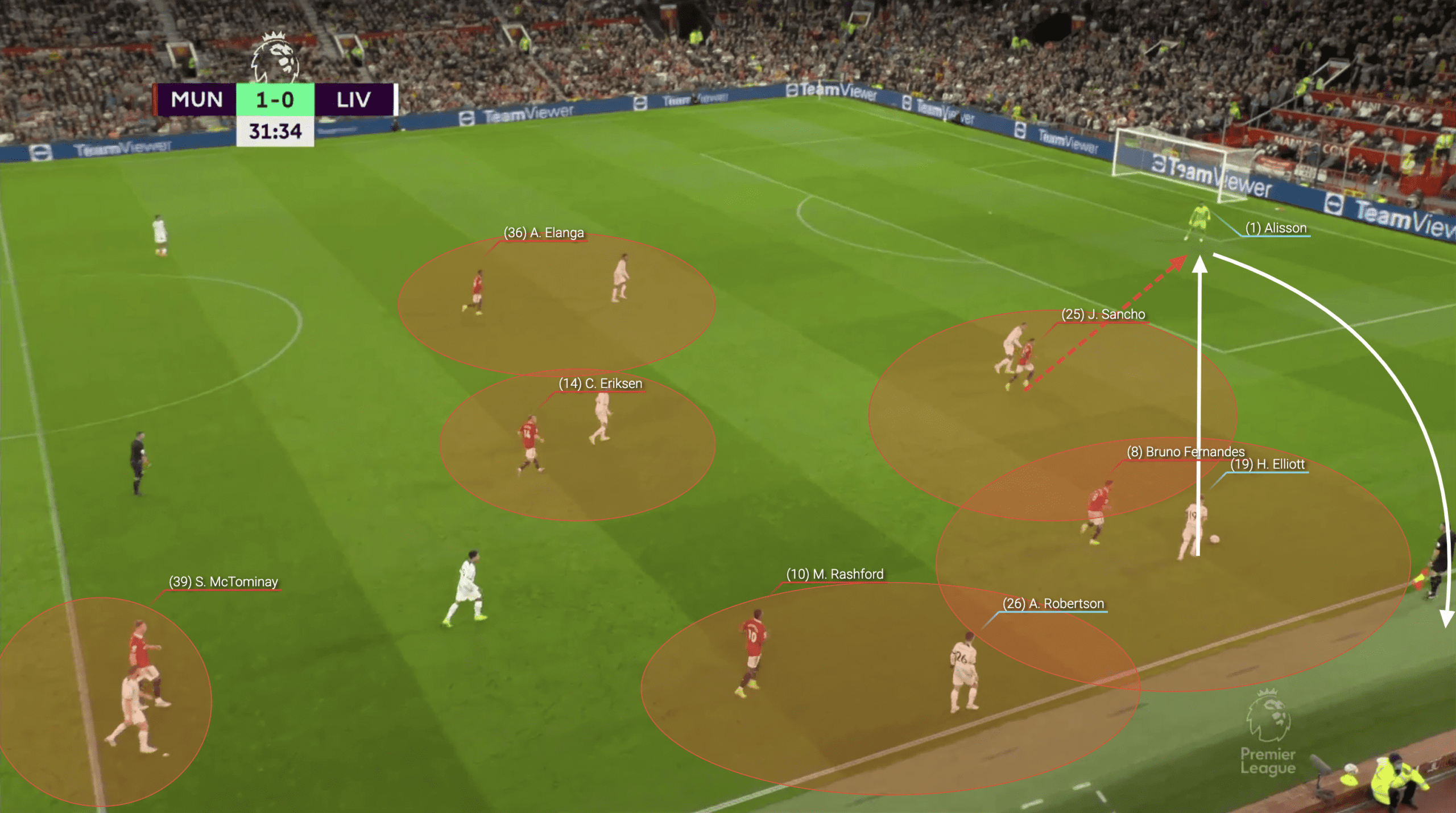
United were consistent in looking to set these pressing traps to force mistakes from Liverpool close to their own goal as they knew that Liverpool would struggle to effectively play through and break the press in the central areas. One of the crucial aspects in the way that United set up against the ball was the way that they went man to man behind the initial press. They were effective in not allowing Liverpool to find an easy pass that would allow them to break through the press.
You see this here as Harvey Elliot has found himself in possession in the left-back area facing his own goal. We already know that this is a pressing trigger but look at the positioning behind the press from United. There are no easy passes for the young midfielder to make. Instead, he is forced to go back to the goalkeeper and Sancho is then able to press that pass aggressively. This forces Alisson to play the ball out of play.
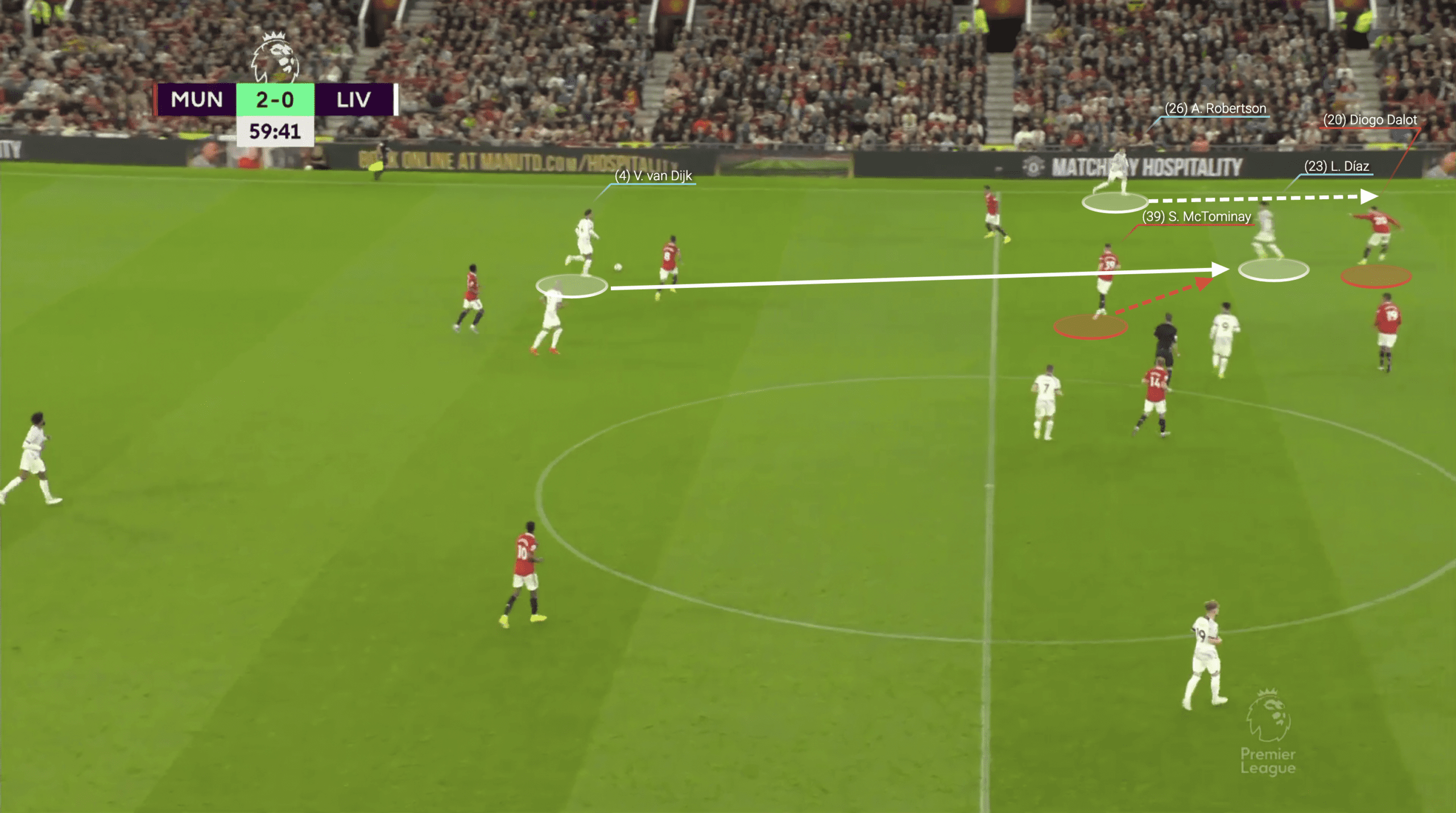
Throughout the match, United were aggressive and proactive in terms of looking to deny Liverpool time and space when they played progressively in the half-spaces. This is traditionally a strength from Liverpool and the wide forwards would often look to receive in these spaces while dragging the fullback with them. That then creates the space wide that Liverpool can look to attack and exploit.
Throughout this game, however, we saw the United fullbacks communicating and passing these players on in order to secure the wide areas from that threat. The United midfield would then act aggressively in snapping across to challenge for the ball. In this example we see Virgil van Dijk playing a pass to Diaz, who as dropped to the half-space, as you can see Dalot is signalling for someone to take the Colombian wide player as he covers wide and Scott McTominay is able to come across to challenge aggressively.
United were more direct
During their first two matches of the season, we saw Manchester United get into considerable trouble when trying to play the ball out from the back Their Spanish international goalkeeper David de Gea is still, despite his error against Brentford, an excellent shot stopper but he is not a modern goalkeeper in that he is comfortable with the ball at his feet. He made poor choices and executed his passes poorly in putting teammates under pressure against Brighton and Brentford. Going into this game then we all expected to see Ten Hag continue with his absolute insistence that United take risks in building their attack from the back.
This, however, was not the case at all as United were more direct and vertical in their attacking approach in this game with De Gea, in particular, looking more comfortable with the freedom to play longer. On reflection, this should probably not come as a surprise as Ten Hag has not been a coach throughout his career who has been absolutely wedded to a single idea of how he wanted his teams to play. Instead, he has been tactically flexible in moulding his approach to the players at his disposal.
It was also striking in this match that United very much focussed their vertical and direct attacks on the right side of the Liverpool defensive structure. They looked to target Trent Alexander Arnold and Joe Gomez throughout this game with passes played into the space vacated by the Liverpool right-back as he pushed into the midfield in transition. These direct passes then released the pace of Elanga or Rashford into space.

In the first two games of the season, we would have seen De Gea receive the ball in these positions before dropping the short pass to Dalot, who is moving wide, or Varane who is central but the issue was that the Spanish goalkeeper consistently played passes that were poorly directed or weighted and that put his teammates under pressure.
In this game, he was free to hit longer passes in this situation as he looked to drop the ball behind the Liverpool defensive line.
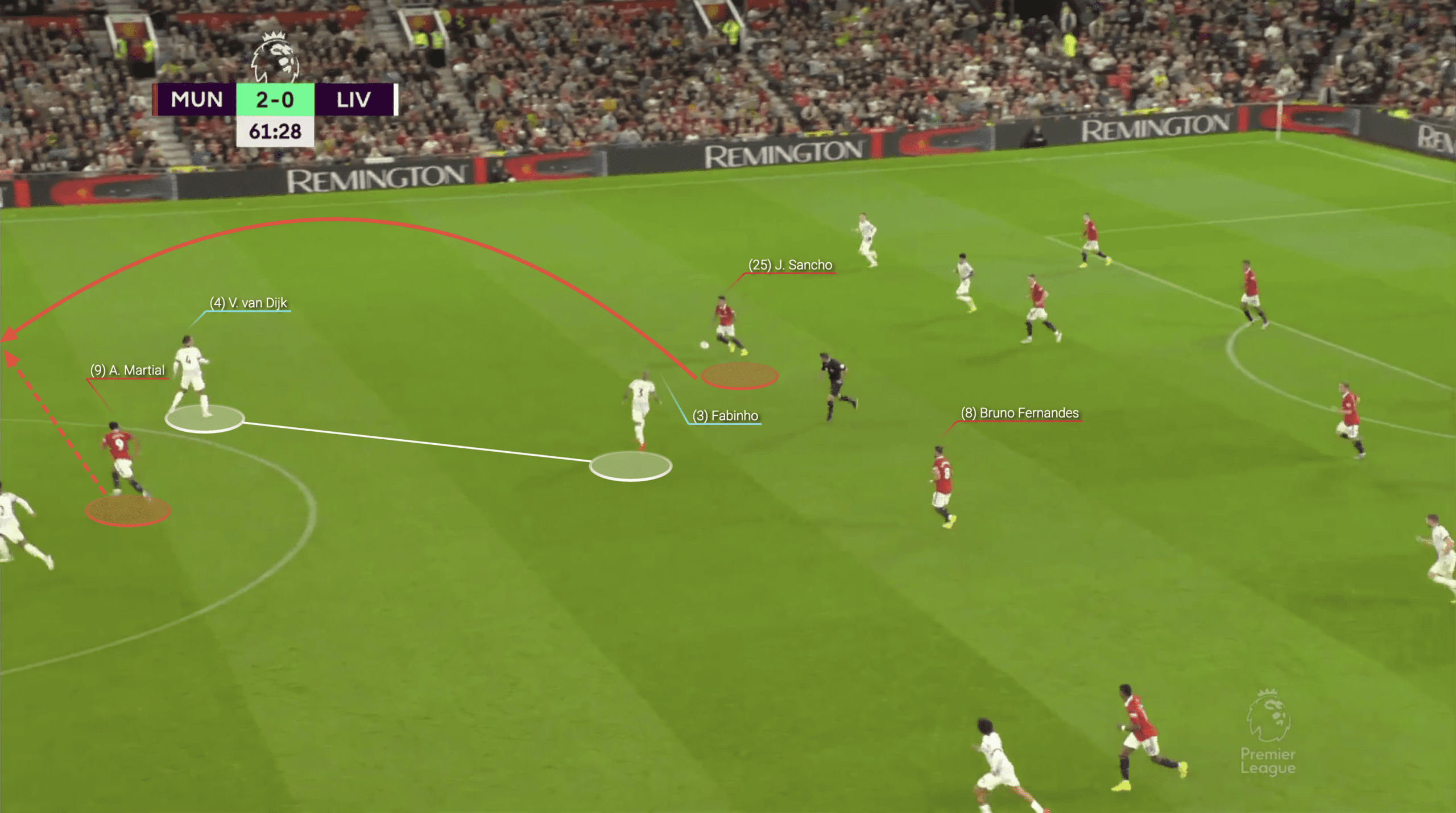
United were consistently aggressive and vertical in moments of transition and after they went ahead, and Liverpool became more aggressive in chasing a goal, we saw United get a lot of joy with direct passes that played into space and allowed their more dynamic forwards to attack.
We see an example of this here as United have cleared and are looking to launch an attacking transition, With Sancho in possession deep inside his own half we can see that Fabinho is not close enough to the ball to put immediate pressure on the ball. The positioning of Van Dijk is also a problem as he has left space behind that can be exploited. It only took a single pass from Sancho to release the run of Martian to attack the space in behind the Dutch defender.
Liverpool lack an attacking focal point
For years we have seen Liverpool under Jurgen Klopp attack in a very intelligent but very structured manner. We would see the well-known front three of Sadio Mane, Roberto Firmino and Mohamed Salah on the pitch but Firmino would consistently drop out of the front line to take up positions in the midfield in which he could receive the ball. Opposition central defenders were then left wondering whether they should follow Furmino or hold their position but at the same time Mane and Salah would be making aggressive diagonal runs to attack any space.
With Sadio Mane now plying his trade in Germany for Bayern Munich and with Roberto Firmino now playing as more of a backup forward though the structures and rotations for Liverpool in their attack feel less effective. Klopp was. of course, frustrated with the fact that their new big money signing Darwin Nunez was sent off last week for a headbutt on Crystal Palace’s Joachim Andersen and the Uruguayan forward may have changed the picture of this game but in truth, Firmino struggled to make any kind of impact on this game as United seemed happy to allow him to drop off into the midfield.
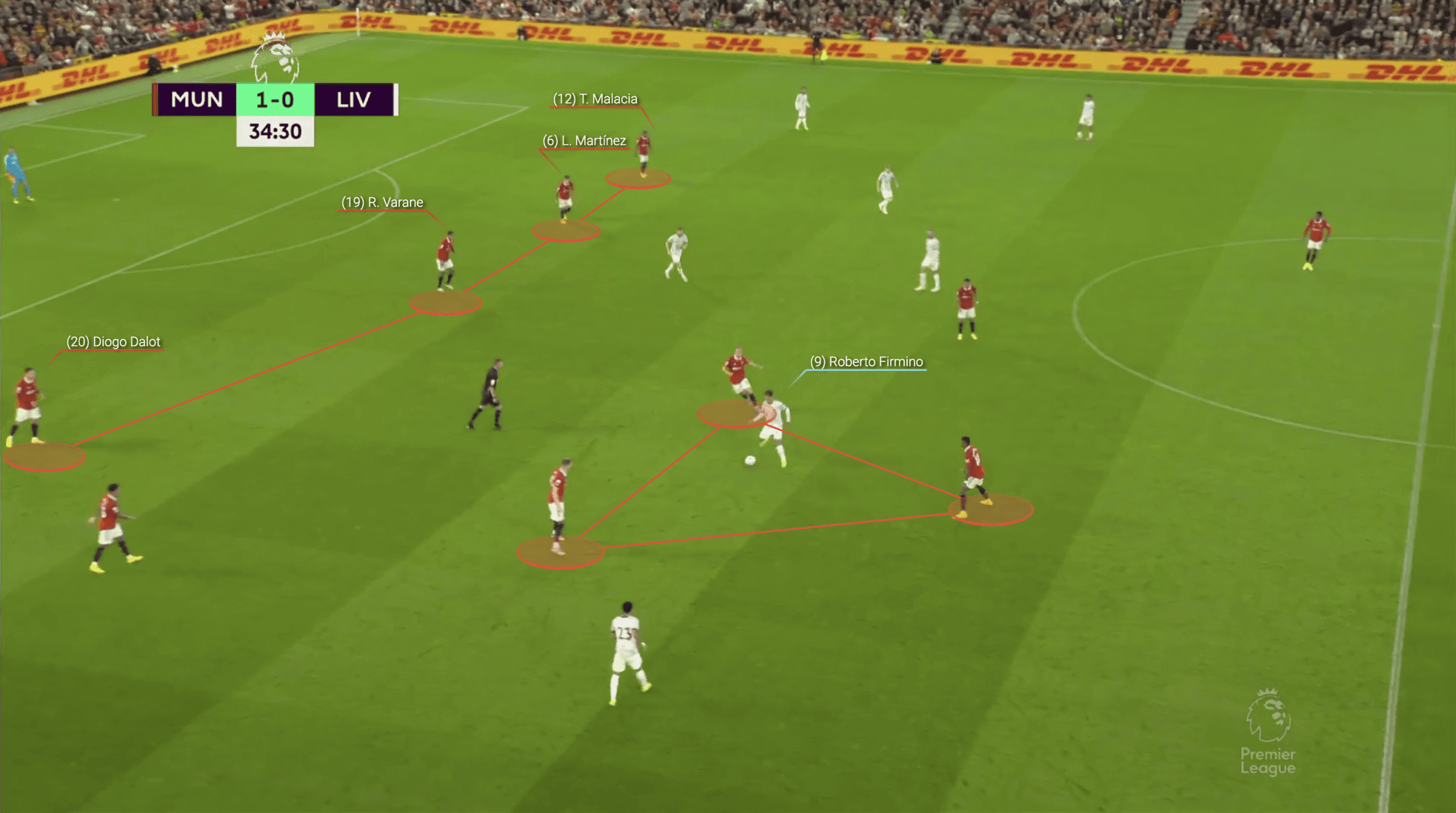
We see this here as Firmino has effectively dropped off into space in front of the United midfield in order to receive the ball. We can see that the United back line is still well spaced and well positioned as nobody has looked to chase Firmino deep. There are also no obvious Liverpool players looking to make runs to act as the focal point in the attack and as such United were largely comfortable in these situations.
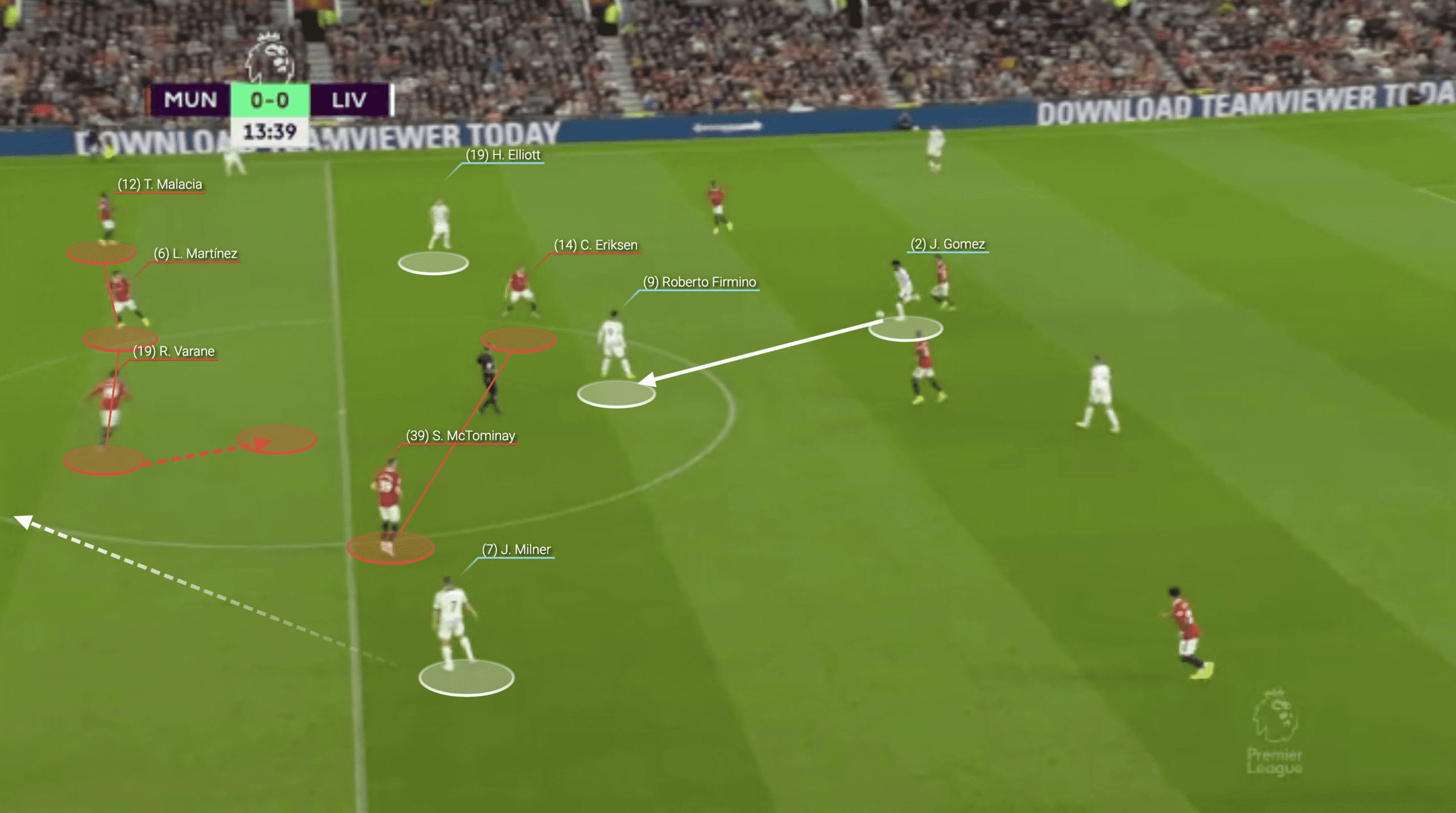
A similar situation here as again Firmino has dropped off and into space in front of the United midfield in order to receive the ball and get out of pressure. As he does so, however, there are no Liverpool players positioned to give an option further forward and in the central areas. Initially, Varane looked to move out to follow the striker but he realised he was out of position and dropped back to the defensive line. Now, in these situations, we might expect to see a midfielder attacking the blind side of Varane but this is not something that Milner really has in his game anymore.
Instead, the emptying of the striker space for Liverpool just served to slow their attack and make them relatively passive in possession.
Conclusion
Towards the end of the game, Cristiano Ronaldo came off the bench for Manchester United. The dynamic and youthful attacking performance in this match from the United attack has put Erik ten Hag in a very strong position in the dressing room and it feels unlikely that the Portuguese striker will start for United over the next handful of games as they are now in a position to go on a strong run.
As for Liverpool, the narrative around the Premier League has shifted its attention to them. Are they too slow and passive in possession now? After three league games, it is fair to say that they do not feel like a Jurgen Klopp side at the moment





Comments